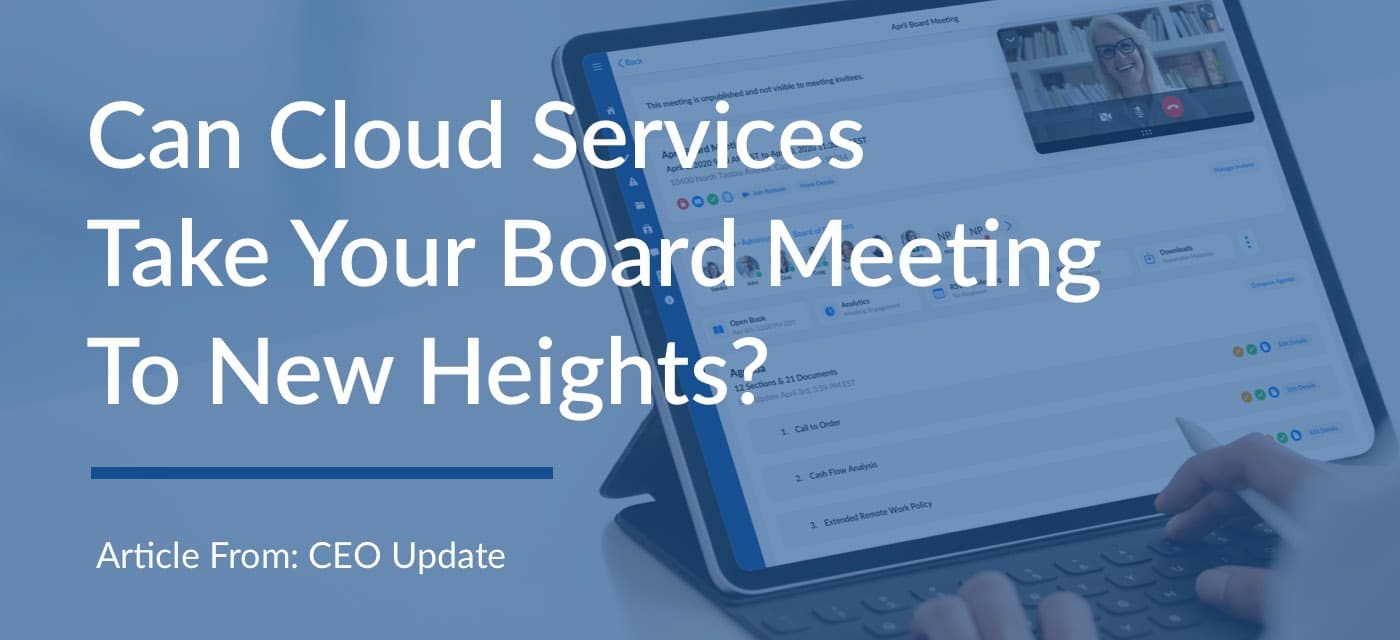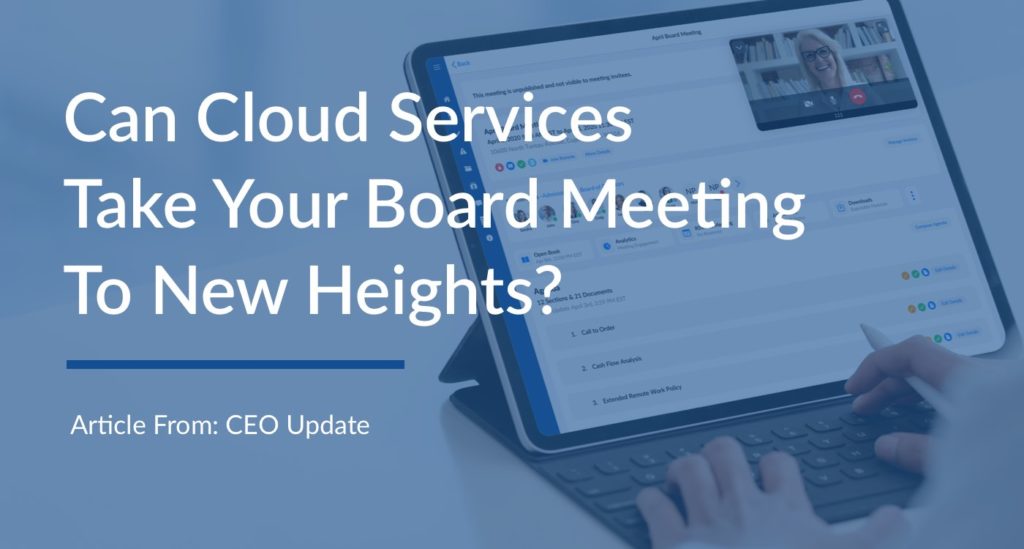 Mobile-friendly, Zoom-integrated portals can improve security, efficiency and convenience of virtual, hybrid or in-person gatherings
Mobile-friendly, Zoom-integrated portals can improve security, efficiency and convenience of virtual, hybrid or in-person gatherings
Board management software may not be top of mind for chief executives and their IT departments, what with virtual meeting platforms and association management systems to worry about.
But products are available to take your virtual or hybrid board meetings from simple Zoom affairs to integrated document-sharing, minute-keeping, messaging and vote-recording experiences using secure portals. Many of those advantages apply to in-person meetings, too.
“It’s a tool that could be helpful, especially going forward when it seems like there’s going to be more and more hybrid meetings,” said Duane Capuano, a senior consultant at board consulting firm Tecker International. “Tools like board management software will help make those meetings run much more smoothly.”
Such services are not new, but they are niche products that have not been a high priority when associations have considered enterprise software needs, he said.
The value of such software goes beyond virtual and hybrid meetings, although they include integrated teleconferencing functions. By creating a secure portal where documents are stored in the cloud, printing and mailing costs are reduced, and these documents—collectively known as “board books”—are delivered to board members more quickly, whether they are attending in person or not. Board books might run 150 pages, and the portals provide a way to review the materials on a computer or tablet or smartphone without carrying around a bundle that could end up being misplaced. That would present liability and confidentiality issues.
“It would help the board members in terms of being easy to work with,” Capuano said. “This would definitely make prepping for the meetings a lot easier, in that all the information’s in one place. It’s easier to exchange information and data with fellow board members or with executive staff.”
Full-suite solutions
Among the better-known cloud-based products is OnBoard, from Passageways, which provides both the nonprofit and corporate market with a full suite of services. Others include Diligent Boards, from Diligent, and Boardvantage, from Nasdaq, the stock exchange operator. Boardable, from Boardable, is another, though with less functionality and a lower price point. It was created with smaller nonprofits in mind. Among the functions Boardable does not include is the ability to annotate shared documents. It does integrate with Zoom and has a mobile app.
“OnBoard saves us significant time and money,” said Henry Stoever, CEO of the $14 million-revenue Association of Governing Boards of Universities and Colleges. “For example, in pre-portal days, teams spent significant time and money to create and mail printed and bound board books.”
Stoever has experience with board-meeting software going back 15 years, including using some of the most established products.
“One of the features I find really helpful is the ability to conduct analytics on what board members are accepting or declining, their availability to participate in board and committee meetings,” he said.
Executives can see “who has downloaded different materials from the portal. One of the key elements for any board meeting or committee meeting is to ensure that the board members read and review the material prior to the meeting,” Stoever said. “So it gives the board chair insights as to who has done what. And it enables each individual board member to evaluate other board members and the board as a whole, and for committee members to evaluate their own committee’s performance. All of those features are needed to help the board gain efficiencies as they conduct their business.” The company has 111 association users out of 2,000 clients, he said. It started in 2003 making employee collaboration software.
“Mostly because of the demographics in the boardroom, the (typical) board meeting of 2020 looked eerily similar to the board meeting of 1920,” Chadha said. “But board management is coming of age.”
Small-group users
The two-staff, $393,000-revenue Association of Women’s Business Centers currently is using OnBoard free in exchange for encouraging its 135 members to use it for their own meetings, in part by demonstrating it. AWBC started gradually with the software about six months ago, but its board meetings are now fully on the platform, CEO Corrinne Hodges said. (She is one of the two staffers.) Women’s Business Centers are funded by the Small Business Administration to help women entrepreneurs start businesses.
“We’ve been doing remote meetings for a long time,” she said. “And we were just capturing those board actions verbally, then using an e-signature platform in some cases if we had a resolution or something.
“The nice thing about OnBoard is it puts all of those activities into one place,” Hodges said. “So I’m not having to go between Google Drive, email, Zoom platform, an e-signature solution. And it’s stored for posterity. So in the event the board is audited, or we’re pursuing accreditation, everything is in that one place, which is really just neat and tidy and organized. That is a more efficient use of time.”
One thing about OnBoard she and her members don’t like is that the Zoom window is too small, she said. So they do tend to use Zoom separately.
“If you open up your invitation to attend from inside OnBoard, you just get a little teeny, tiny window the size of your cell phone,” Hodges said. “That’s the only real complaint.
“It’s quicker and easier, administratively, to set up a meeting, and quicker and easier to capture the meeting minutes,” she said. “Having this official record is more in line with 21st-century expectations, rather than just writing down who all motioned.”
One-man shop
Tim Pyle, executive director and sole employee of the $172,000-revenue International Paruresis Association, uses Boardable. He has a 10-user package but is able to add users at a low cost to accommodate his 30 volunteer leaders.
“Some folks think, ‘Oh, I have another thing that I have to log into,” said Pyle. “But with all the emails that you get, this makes it easier to communicate and share documents and remind people about meetings.”
Boardable CEO Jeb Banner said the company has nearly 100 association customers and about 20 chambers of commerce. Users take advantage of a free trial and then purchase a monthly or annual subscription that starts at $49 a month for a small organization with 10 users. Some customers pay hundreds of dollars monthly to support hundreds of users, he said.
“We’re really trying to provide a low-cost, self-service alternative,” Banner said.
Boardable includes tools such as polling and assigning tasks to committees, Pyle said. But like board members of AWBC with the OnBoard portal, IPA directors use Zoom outside of the Boardable portal.
“I’m a one-man shop. It’s affordable but super helpful to me,” he said.




